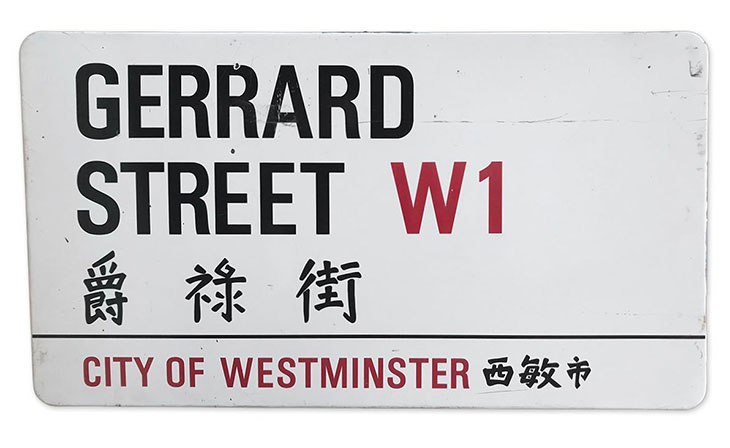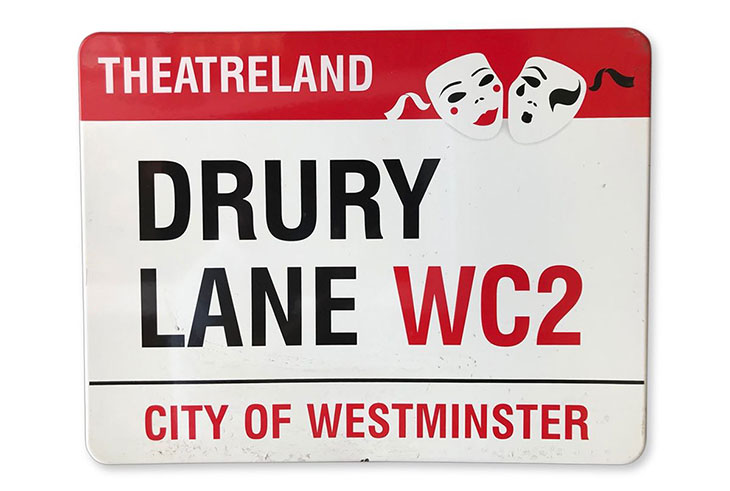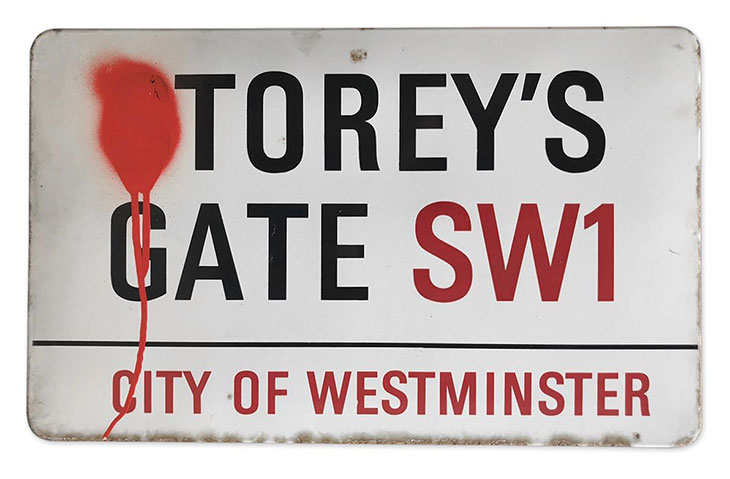If you ask most people what the typical London street sign looks like, they will probably describe something that looks very like the classic Westminster design: white enamel with neat black lettering and the postal district in red, then the name of borough in red across the bottom, all in sans serif. This classic and copyrighted design – many genuine examples of which are currently being auctioned online by Catherine Southon Auctioneers – feels historic but was in fact conceived as recently as 1967 by Misha Black’s Design Research Unit. Black was commissioned by Westminster City Council to design a simple and striking template that would replace the existing anarchic street sign policy – which he did with great success. ‘[Westminster’s] street template has transcended its specific purpose and has become representative of the entirety of London,’ writes Alistair Hall of the Westminster model in London Street Signs (2020), his superlative study of the subject. ‘Similarly to the London Underground roundel, it has become a visual shorthand for the city.’
Black was paid an initial fee of £540 plus expenses for his work. That might have been enough to buy two or three of the signs that are being auctioned in this month’s sale – although perhaps not. Earlier this year the same auction house sold a street sign from Abbey Road for £37,000 on an estimate of £1,000–£2,000 (presumably paid by somebody looking for a unique addition to their Beatles collection). By comparison, a sign for Boscobel Street, a fine but admittedly forgettable street off the Edgware Road, went for a bargain £90: clear evidence of the hierarchy of London streets. While £37k might be hard to beat, there are big hitters up for auction this month, including original signs from Shaftesbury Avenue, Haymarket, the Strand and St Martin’s Lane; Chinatown classics such as Gerrard Street and Lisle Street; Brewer Street in Soho; and Whitehall and Millbank for the political junkies. There are dozens more, too – spanning central London and heading into St John’s Wood, Maida Vale and Notting Hill, an appealing mix of major thoroughfares and residential streets. (The sale also includes significant train and tube memorabilia and signage, including some gorgeous and hefty enamel roundels for Tottenham Court Road, Oxford Street and Bond Street tube stations, which are likely to raise substantial amounts.)

An enamelled iron street sign for Gerrard Street in Chinatown (estimate £60–£100). Courtesy Catherine Southon Auctioneers and Valuers
The appeal of the street signs is clear. For the same price as a piece of affordable original art, a person can own something that may well have genuinely deep personal and emotional significance. It might be a road on which they lived or worked or it could be a street that shares their name. Pay a little bit more, and you can get an artefact with wider cultural significance, too – a physical piece of London’s Theatreland or part of its political landscape.
Each sign will have meaning for somebody, while some will have meaning for almost everybody. But can such objects really evoke such strong emotions when removed from their intended locations, detached from the noise, bustle and the grubby smell of the city streetscape and instead placed within the relatively anodyne confines of the modern home, perhaps overlooking the kitchen sofa in the side return extension? That’s questionable, but these signs will bring at least some recall of youthful misadventures into the home, a potential trigger for a trip down memory (or indeed Drury) lane.

An enamelled iron street sign for Drury Lane in Theatreland (estimate £300–£500) Courtesy Catherine Southon Auctioneers and Valuers
And they look good too, thanks to Professor Black’s eye for design. Other London street signs might have more elan – faded painted signs are a personal favourite; then there are the fantastic black tiled nameplates of Hampstead, and some fine ceramic and milk-glass examples from various areas still extant. But there’s something authoritative about the Westminster style, thanks both to the dominance of the design and their place of origin, perhaps the single borough that all Londoners have some connection with.

An enamelled iron street sign for Storey’s Gate (estimate £60–£100)
The signs now at auction have come from a private collection. They were most likely acquired at one of the occasional sales held by Westminster City Council, which periodically shrinks its stash of old signs. Street signs are built to last by design but they do get taken down for all kinds of reasons – the Abbey Road sign has to be replaced more regularly than most because of incessant Beatles graffiti. In 2010, meanwhile, Westminster launched its Legible London campaign, which involved upgrading all street signs to make them more ‘user-friendly’ – many of the old signs were sold, while one from Shaftesbury Avenue was donated to the V&A. Some of the examples in the current auction show signs of wear and tear, which for me only adds to the appeal – the first ‘S’ in Storey’s Gate is obscured by a smear of possibly politically motivated red paint (‘Torey’s Gate’). Orange Yard is still covered in old stickers while Clifton Gardens and Horse Guards Avenue are among those with the battered and worn appearance of a life well lived.
The Transport and Westminster Street Signs sale at Catherine Southon Auctioneers and Valuers runs online until 24 September.

Street smart – how to own a piece of London’s West End
Photo: Oli Scarff/Getty Images
Share
If you ask most people what the typical London street sign looks like, they will probably describe something that looks very like the classic Westminster design: white enamel with neat black lettering and the postal district in red, then the name of borough in red across the bottom, all in sans serif. This classic and copyrighted design – many genuine examples of which are currently being auctioned online by Catherine Southon Auctioneers – feels historic but was in fact conceived as recently as 1967 by Misha Black’s Design Research Unit. Black was commissioned by Westminster City Council to design a simple and striking template that would replace the existing anarchic street sign policy – which he did with great success. ‘[Westminster’s] street template has transcended its specific purpose and has become representative of the entirety of London,’ writes Alistair Hall of the Westminster model in London Street Signs (2020), his superlative study of the subject. ‘Similarly to the London Underground roundel, it has become a visual shorthand for the city.’
Black was paid an initial fee of £540 plus expenses for his work. That might have been enough to buy two or three of the signs that are being auctioned in this month’s sale – although perhaps not. Earlier this year the same auction house sold a street sign from Abbey Road for £37,000 on an estimate of £1,000–£2,000 (presumably paid by somebody looking for a unique addition to their Beatles collection). By comparison, a sign for Boscobel Street, a fine but admittedly forgettable street off the Edgware Road, went for a bargain £90: clear evidence of the hierarchy of London streets. While £37k might be hard to beat, there are big hitters up for auction this month, including original signs from Shaftesbury Avenue, Haymarket, the Strand and St Martin’s Lane; Chinatown classics such as Gerrard Street and Lisle Street; Brewer Street in Soho; and Whitehall and Millbank for the political junkies. There are dozens more, too – spanning central London and heading into St John’s Wood, Maida Vale and Notting Hill, an appealing mix of major thoroughfares and residential streets. (The sale also includes significant train and tube memorabilia and signage, including some gorgeous and hefty enamel roundels for Tottenham Court Road, Oxford Street and Bond Street tube stations, which are likely to raise substantial amounts.)
An enamelled iron street sign for Gerrard Street in Chinatown (estimate £60–£100). Courtesy Catherine Southon Auctioneers and Valuers
The appeal of the street signs is clear. For the same price as a piece of affordable original art, a person can own something that may well have genuinely deep personal and emotional significance. It might be a road on which they lived or worked or it could be a street that shares their name. Pay a little bit more, and you can get an artefact with wider cultural significance, too – a physical piece of London’s Theatreland or part of its political landscape.
Each sign will have meaning for somebody, while some will have meaning for almost everybody. But can such objects really evoke such strong emotions when removed from their intended locations, detached from the noise, bustle and the grubby smell of the city streetscape and instead placed within the relatively anodyne confines of the modern home, perhaps overlooking the kitchen sofa in the side return extension? That’s questionable, but these signs will bring at least some recall of youthful misadventures into the home, a potential trigger for a trip down memory (or indeed Drury) lane.
An enamelled iron street sign for Drury Lane in Theatreland (estimate £300–£500) Courtesy Catherine Southon Auctioneers and Valuers
And they look good too, thanks to Professor Black’s eye for design. Other London street signs might have more elan – faded painted signs are a personal favourite; then there are the fantastic black tiled nameplates of Hampstead, and some fine ceramic and milk-glass examples from various areas still extant. But there’s something authoritative about the Westminster style, thanks both to the dominance of the design and their place of origin, perhaps the single borough that all Londoners have some connection with.
An enamelled iron street sign for Storey’s Gate (estimate £60–£100)
The signs now at auction have come from a private collection. They were most likely acquired at one of the occasional sales held by Westminster City Council, which periodically shrinks its stash of old signs. Street signs are built to last by design but they do get taken down for all kinds of reasons – the Abbey Road sign has to be replaced more regularly than most because of incessant Beatles graffiti. In 2010, meanwhile, Westminster launched its Legible London campaign, which involved upgrading all street signs to make them more ‘user-friendly’ – many of the old signs were sold, while one from Shaftesbury Avenue was donated to the V&A. Some of the examples in the current auction show signs of wear and tear, which for me only adds to the appeal – the first ‘S’ in Storey’s Gate is obscured by a smear of possibly politically motivated red paint (‘Torey’s Gate’). Orange Yard is still covered in old stickers while Clifton Gardens and Horse Guards Avenue are among those with the battered and worn appearance of a life well lived.
The Transport and Westminster Street Signs sale at Catherine Southon Auctioneers and Valuers runs online until 24 September.
Unlimited access from just $16 every 3 months
Subscribe to get unlimited and exclusive access to the top art stories, interviews and exhibition reviews.
Share
Recommended for you
Tourist for a day – the London Eye may be ancient now, but it’s well worth a spin
The giant ferris wheel may now be part of the furniture – but the view from on high is still revolutionary
‘Conservative in art, radical in politics’: James Boswell and the Artists’ International Association
Boswell’s acutely observed satires sum up the social and political issues of the 1930s
Westminster Cathedral’s ceilings like the sky
The influence of glittering Byzantine churches can be found in the impressive mosaics of Westminster Cathedral – including a new work by Tom Phillips